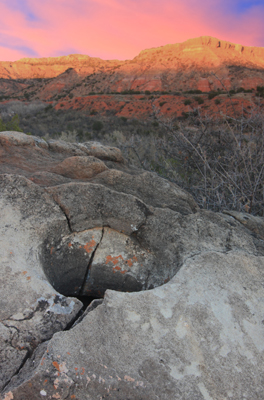 Although long cast into the ash heap of forgotten history by modern west Texas residents, the Llano Estacado was once an enduring mecca of Native American cultures. Some of the last free-roaming Indian civilizations in the country, bands of combined Kiowa, Southern Cheyenne, and Comanche, were only eradicated from the Llano Estacado a mere 140 years ago during a major U.S. military campaign in the summer of 1874 known as the Red River War. Defeated only two years before their Northern Plains counterparts and the infamous Battle of Little Big Horn, Southern Plains Indians were among the last Native Americans to give up their way of life and this land then known as “Comancheria” to America’s Manifest Destiny expansion. In fact, serious armed skirmishes between American settlers and Native Indians leaving the Oklahoma reservations occurred on the Llano Estacado as late as 1877 (Battle of Yellow House Canyon). Yet, when one considers how recently the Llano was under firm control by the “Lords of the Southern Plains”- mainly the Comanches, it is amazing how little evidence of their existence remains.
Although long cast into the ash heap of forgotten history by modern west Texas residents, the Llano Estacado was once an enduring mecca of Native American cultures. Some of the last free-roaming Indian civilizations in the country, bands of combined Kiowa, Southern Cheyenne, and Comanche, were only eradicated from the Llano Estacado a mere 140 years ago during a major U.S. military campaign in the summer of 1874 known as the Red River War. Defeated only two years before their Northern Plains counterparts and the infamous Battle of Little Big Horn, Southern Plains Indians were among the last Native Americans to give up their way of life and this land then known as “Comancheria” to America’s Manifest Destiny expansion. In fact, serious armed skirmishes between American settlers and Native Indians leaving the Oklahoma reservations occurred on the Llano Estacado as late as 1877 (Battle of Yellow House Canyon). Yet, when one considers how recently the Llano was under firm control by the “Lords of the Southern Plains”- mainly the Comanches, it is amazing how little evidence of their existence remains.
 The environment of the Llano Estacado is partly to blame. Unlike the desert southwest, where countless Pueblo ruins and rock art sites are perfectly preserved upon solidly stable rock formations in a dry climate, the semi-arid nature of the Llano Estacado provides just enough moisture and erosive weathering of the geologically young Llano canyon systems to destroy most rock art sites. Not to say they don’t exist here, they do, but the prevalence of private land ownership in Texas makes access to the few sites that still exist very difficult. Also, given the nomadic nature of most Llano Indian cultures, there were very few permanent settlement. With the exception of remnant pueblos of the Antelope Creek people found on the northern periphery of the Llano along the Canadian River, the Llano canyons contain little to no sign of fixed habitations. What evidence there is of long-term use of particular locations by Native cultures in these canyons is subtle and found bore into stone. If you know where to look, you can find bedrock “mortar” holes dotting the landscape of the Llano canyons. These distinct holes carved deep into boulders, are the most prolific artifact of Native American life found today in the canyons of the Llano Estacado.
The environment of the Llano Estacado is partly to blame. Unlike the desert southwest, where countless Pueblo ruins and rock art sites are perfectly preserved upon solidly stable rock formations in a dry climate, the semi-arid nature of the Llano Estacado provides just enough moisture and erosive weathering of the geologically young Llano canyon systems to destroy most rock art sites. Not to say they don’t exist here, they do, but the prevalence of private land ownership in Texas makes access to the few sites that still exist very difficult. Also, given the nomadic nature of most Llano Indian cultures, there were very few permanent settlement. With the exception of remnant pueblos of the Antelope Creek people found on the northern periphery of the Llano along the Canadian River, the Llano canyons contain little to no sign of fixed habitations. What evidence there is of long-term use of particular locations by Native cultures in these canyons is subtle and found bore into stone. If you know where to look, you can find bedrock “mortar” holes dotting the landscape of the Llano canyons. These distinct holes carved deep into boulders, are the most prolific artifact of Native American life found today in the canyons of the Llano Estacado.
Bedrock mortars are anthropologically formed circular holes in rock used by Native Americans for grinding food products. These holes served as bowls, and food was ground within them using an elongated smooth stone or blunt stick called a pestle. Lesser and more shallow carved depressions in rocks, called metates or cupules, also can be found here. Native American women used the mortar holes to prepare beans and/or nuts into a flour paste meal that was turned into tortilla-like breads. It is most likely that the mortars of Palo Duro Canyon were used to grind mesquite beans. Amazingly, as common as these artifacts are, much debate remains among archeologists as to the exact use of the mortar holes. Maybe this is because of the diversity of mortars and the potential that they were used for a wide variety of purposes. Some are shallow, while others are dug (likely over the course of many centuries) until they empty all the way through the parent rock. Mortars elsewhere have been found with “lids”, and mortars of various sizes are found at many mortar hole sites. Other potential uses include water storage, and some researchers have even hypothesized that mortars may have been used as vessels for fermentation.
Bedrock mortar holes found in Palo Duro Canyon State Park are “drilled” into Trujillo sandstone boulders. Instead of being found at the natural elevation of Trujillo, generally between 3,100 and 3,200 feet above sea level, mortars are instead embedded within boulders of Trujillo which have long since calved off during past millenia and come to rest on top of the Quartermaster geologic layer not far above the Prairie Dog Town Fork of the Red or one of the other major tributaries, as the availability of water was an important aspect of food preparation. Examples of mortar holes found at various locations across Palo Duro Canyon are shown below.
Two of the most dramatic bedrock mortar hole sites in Palo Duro Canyon State Park are pictured below. One is a boulder containing more than eight holes (with evidence of additional broken mortars along its edges) that is part of a larger mortar hole boulder field near the popular Givens, Spicer & Lowry Trail. The other is a massive boulder containing a complex arrangement of at least 30-40 mortar holes deep in the recesses of the Palo Duro Canyon backcountry, not far from what was once a large winter Indian camp and the site of General MacKenzie’s surprise attack during the Battle of Palo Duro Canyon. Both of these sites represent strategically important Native American bedrock milling stations within the canyon. Not only did they apparently congregated in great numbers to prepare sustenance for the tribe at these locations, but the sites were utilized repeatedly over untold centuries and shared by unknown generations of successive cultures.
It is worth noting that the protection afforded to these fragile historical artifacts in Palo Duro Canyon State Park is very inconsistent and inadequate. One site, located in the middle of a popular campground, is surrounded by a small metal chain fence in an apparent weak attempt to detract those who would deface it. Yet the remarkable specimen of mortar boulders found just a few steps away from the popular GSL Trail are totally unmarked and unprotected. Unfortunately, most of the mortar hole sites in Palo Duro are increasingly suffering from natural damage, including fracturing that occurs when moisture compromises cracks emanating from the holes and then breaks the rocks upon freezing. Others have fragmented enough that they appear to be crumbling. Like many of the locations featured on the pages of this blog, the mortars of Palo Duro Canyon State Park are not noted on official maps or brochures. Although this strategy may in fact prevent visitation from many, including folks who would be inclined to do harm to these artifacts, the lack of acknowledgement and protection provided by TP&WD does leave them prone to intentional and malicious defacing from graffiti if visitors do discover them.


I encourage readers of this blog to venture out on their own to find mortars in Palo Duro Canyon State Park. Make an adventure out of it! The thrill of the hunt makes for an excellent learning opportunity for families, and helps youngsters gain a certain appreciation for this area’s history which you can not obtain in a classroom. If you do find Native American mortars in the Llano canyons (or elsewhere), please treat them with the utmost respect. They are some of the only remaining artifacts of past cultures in these canyons, and we should be diligent to preserve them. Of course, if you cannot make it to visit these historical sites yourself, please follow my adventures in documenting the mortar holes of Palo Duro Canyon on the pages of The Caprock Canyoneer.

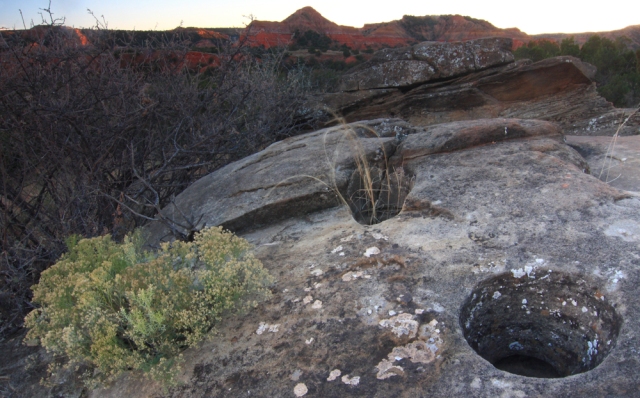
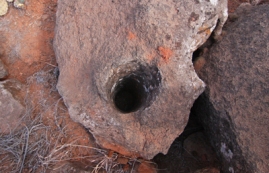

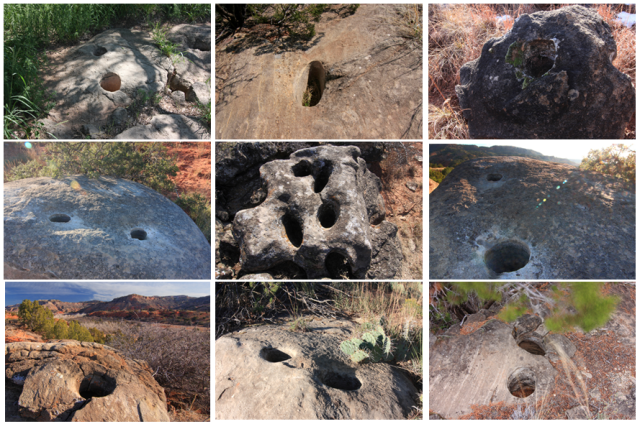



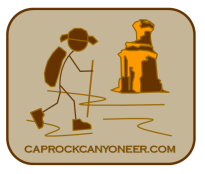
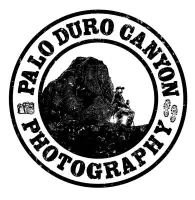

























































































































































Awesome
Pingback: True Story Behind The Big Weird Holes In Rocks In TX Panhandle